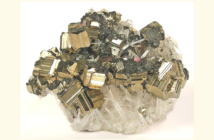The Sodium-nickel chloride (Na-NiCl2) battery was developed in 1985 by ZEBRA (the Zeolite Battery Research Africa Project) headed by Dr. Johan Coetzer at CSIR (the Council for Scientific and Industrial Research) in Pretoria, South Africa. The technical name for the Sodium-nickel chloride battery is Na-NiCl2 battery.
Basic Construction of a ZEBRA cell
The sodium-nickel chloride battery (ZEBRA) contains NiCl2/FeCl2 as the cathode and sodium metal as the anode. A ceramic Na- β”-Al2O3 electrolyte (Na ion conductor) is used to separate the two terminals (anode and cathode). A secondary electrolyte of liquid NaAlCl4 is used in the transportation of sodium ion to the positive electrode. The cell operates at around 300°C in order to benefit from higher diffusivity among solid reactants in the cathode and higher conductivity of the solid electrolyte.
According to the researchers, both NaAlCl4 and NiCl2 are hygroscopic (they absorb moisture from the surrounding environment) and are tricky to handle. The standard practice is to load the cells in their discharged state, by mixing a granulated mixture of NaCl and nickel powder in the cell and filling the remaining spaces with the electrolyte.

Advantages:
- Needs no air conditioning
- Long cycle life combined with a long calendar life (15 years or more)
- SOH (State of Health) and SOC (State of Charge) indication, remote monitoring of the systems
- High energy density (complete battery level: 170 kWh/m3,120 kWh/ton and cell level: 328 KWh/ m3 , 142 KWh/ton)
- Maintenance-free
- High recyclability of the raw material and zero emission
Applications:
- EV (electric vehicle) cars
- HEV (hybrid electric vehicle) trucks, buses, vans
- Stationary field
- Distributed renewable generators (micro wind turbine and large PV plants)
- For grid support (with voltage requirements up to 600V)
Related Articles:
Biodegradable Battery for Medical Use
Energy Efficiency: Electric Cars



